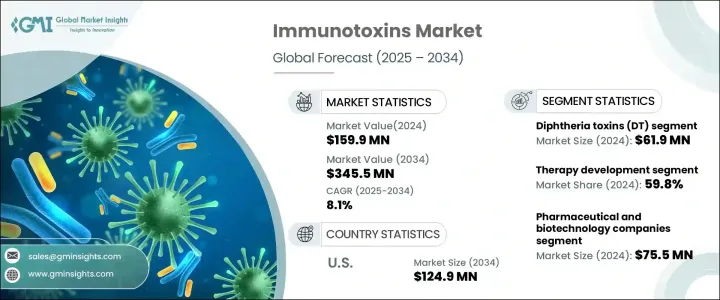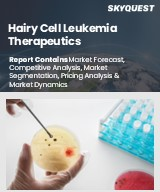
|
시장보고서
상품코드
1708181
세계의 면역 독소 시장 기회, 성장 촉진요인, 산업 동향 분석 및 예측(2025-2034년)Immunotoxins Market Opportunity, Growth Drivers, Industry Trend Analysis, and Forecast 2025 - 2034 |
||||||
세계 면역 독소 시장은 2024년 1억 5,990만 달러에 달했고, 2025-2034년 연평균 8.1% 성장할 것으로 예측됩니다.
면역항암제는 단일클론항체 또는 표적 분자와 강력한 독소를 결합한 치료제입니다. 그 메커니즘은 암세포나 질병 세포와 같은 표적 세포 표면에 존재하는 항원에 항체를 결합시키는 것을 포함합니다. 그 후, 독소 성분이 필수 세포 과정을 파괴하여 표적 세포를 사멸시킵니다. 만성 질환에 대한 표적 치료의 채택이 증가함에 따라 시장 성장의 주요 촉진요인이 되고 있습니다. 면역 독소를 포함하는 표적 치료는 질병을 유발하는 세포를 특이적으로 공격하기 때문에 부작용이 감소하고 환자의 예후가 개선됩니다. 이러한 장점으로 인해 암 및 만성질환 관리에서 면역 독소 기반 치료가 증가하고 있으며, 이는 시장 확대의 원동력이 되고 있습니다.

독소 유형에 따라 시장은 디프테리아 독소(DT), 탄저균 기반 독소, 슈도모나스 외 독소(PE), 리보솜 불활성화 단백질 기반 면역 독소, 기타 면역 독소로 분류됩니다. 디프테리아 독소(DT) 부문은 2024년 6,190만 달러로 평가되었고, 예측 기간 동안 8.1%의 연평균 복합 성장률(CAGR)을 보일 것으로 예측됩니다. 이러한 성장은 디프테리아 독소의 강력한 치료 잠재력으로 인해 표적 세포의 단백질 합성을 억제하여 세포 사멸을 유도하기 때문입니다. 디프테리아 독소와 IL-2 수용체 표적 조각을 결합한 융합 단백질인 Denileukin diftitox는 DT 부문의 성장을 강화하는 세포 사멸 작용의 한 예입니다. 특히 디프테리아 독소 기반 면역 독소에 대한 지속적인 연구와 규제 당국의 승인은 이 부문의 성장에 더욱 기여하고 있습니다.
| 시장 범위 | |
|---|---|
| 시작 연도 | 2024년 |
| 예측 연도 | 2025-2034년 |
| 시작 금액 | 1억 5,990만 달러 |
| 예상 금액 | 3억 4,550만 달러 |
| CAGR | 8.1% |
용도별로는 생물의학 연구와 치료제 개발로 분류됩니다. 치료 개발 분야는 2024년 59.8%의 점유율로 시장을 주도했습니다. 이 분야의 우위는 암 발병률 증가와 임상 현장에서의 면역 독소 사용 증가에 기인합니다. 백혈병, 림프종, 다발성 골수종과 같은 혈액학적 악성 종양의 발병률 증가는 면역 독소 기반 치료제에 대한 수요를 증가시켜 시장 성장을 더욱 촉진하고 있습니다.
시장은 최종사용자, 제약 및 생명공학 기업, CRO 및 CMO, 학계 및 연구기관, 기타 최종 사용자로 분류됩니다. 제약 및 생명공학 기업은 2024년 7,550만 달러로 이 부문을 지배했습니다. 이들 기업은 암 및 만성질환에 대한 첨단 면역 독소 치료제를 개발하기 위해 연구개발에 많은 투자를 하고 있으며, 건강한 세포를 보존하면서 질병 세포를 표적으로 삼는 데 초점을 맞추고 있으며, CRO, CMO, 학술 기관과의 제휴를 통해 제품 상용화 및 개발을 가속화하고 시장 개척에 크게 기여하고 있습니다. 시장 개척에 크게 기여하고 있습니다.
미국 면역 독소 시장은 2034년 1억 2,490만 달러 규모에 달했습니다. 암 발병률 증가와 사망률 증가로 인해 표적 면역 독소 기반 치료법에 대한 수요가 증가하고 있으며, 이는 미국 시장에서의 존재감을 더욱 높이고 있습니다.
목차
제1장 조사 방법과 조사 범위
제2장 주요 요약
제3장 업계 인사이트
- 생태계 분석
- 업계에 대한 영향요인
- 성장 촉진요인
- 업계의 잠재적 리스크&과제
- 성장 가능성 분석
- 규제 상황
- 향후 시장 동향
- 갭 분석
- Porter's Five Forces 분석
- PESTEL 분석
제4장 경쟁 구도
- 서론
- 기업 점유율 분석
- 기업 매트릭스 분석
- 주요 시장 기업 - 경쟁 분석
- 경쟁 포지셔닝 매트릭스
- 전략 대시보드
제5장 시장 추산 및 예측 : 독소 유형별, 2021년-2034년
- 주요 동향
- 디프테리아 독소(DT)
- 탄저균 기반 독소
- 슈도모나스 외독소(PE)
- 리보솜 불활성화 단백질 기반 면역 독소
- 기타 독소 유형
제6장 시장 추산 및 예측 : 용도별, 2021년-2034년
- 주요 동향
- 바이오메디컬 연구
- 치료 개발
제7장 시장 추산 및 예측 : 최종 용도별, 2021년-2034년
- 주요 동향
- 제약 기업 및 바이오테크놀러지 기업
- CRO 및 CMO
- 학술기관 및 연구기관
- 기타 최종 용도
제8장 시장 추산 및 예측 : 지역별, 2021년-2034년
- 주요 동향
- 북미
- 미국
- 캐나다
- 유럽
- 독일
- 영국
- 프랑스
- 스페인
- 이탈리아
- 네덜란드
- 아시아태평양
- 중국
- 인도
- 일본
- 호주
- 한국
- 라틴아메리카
- 브라질
- 멕시코
- 아르헨티나
- 중동 및 아프리카
- 사우디아라비아
- 남아프리카공화국
- 아랍에미리트(UAE)
제9장 기업 개요
- Abcam
- Bio-Techne
- Cayman Chemical
- Creative Biolabs
- Enzo Biochem
- List Biological Labs
- Merck KGaA
- Quadratech Diagnostics
- Santa Cruz Biotechnology
- The Native Antigen Company
- Thermo Fisher Scientific
The Global Immunotoxins Market reached USD 159.9 million in 2024 and is expected to grow at a CAGR of 8.1% from 2025 to 2034. Immunotoxins are therapeutic agents that combine a monoclonal antibody or a targeting molecule with a potent toxin. Their mechanism involves binding the antibody to antigens present on the surface of target cells, such as cancerous or diseased cells. The toxin component then kills the targeted cells by disrupting essential cellular processes. The increasing adoption of targeted therapies for chronic conditions is a major driver of market growth. Targeted therapies, including immunotoxins, specifically attack disease-causing cells, reducing adverse reactions and improving patient outcomes. These benefits are driving the increased use of immunotoxin-based treatments in cancer and chronic disease management, fueling market expansion.

The market is segmented by toxin type into diphtheria toxins (DT), anthrax-based toxins, pseudomonas exotoxins (PE), ribosome-inactivating protein-based immunotoxins, and other immunotoxins. The diphtheria toxins (DT) segment accounted for USD 61.9 million in 2024 and is expected to grow at a CAGR of 8.1% during the forecast period. This growth is attributed to the strong therapeutic potential of diphtheria toxins, which work by inhibiting protein synthesis in targeted cells, leading to cell death. Denileukin diftitox, a fusion protein that combines diphtheria toxin with an IL-2 receptor-targeting fragment, exemplifies the cytocidal action that reinforces the growth of the DT segment. Ongoing research and regulatory approvals, particularly for diphtheria toxin-based immunotoxins, further contribute to the expansion of this segment.
| Market Scope | |
|---|---|
| Start Year | 2024 |
| Forecast Year | 2025-2034 |
| Start Value | $159.9 Million |
| Forecast Value | $345.5 Million |
| CAGR | 8.1% |
By application, the market is categorized into biomedical research and therapy development. The therapy development segment led the market with a 59.8% share in 2024. Its dominance is driven by the increasing prevalence of cancer and the rising use of immunotoxins in clinical settings. The growing incidence of hematological malignancies such as leukemia, lymphoma, and multiple myeloma is boosting the demand for immunotoxin-based therapies, further propelling market growth.
Based on end use, the market is divided into pharmaceutical and biotechnology companies, CROs and CMOs, academic and research institutes, and other end users. Pharmaceutical and biotechnology companies dominated the segment with USD 75.5 million in 2024. These companies invest extensively in research and development to create advanced immunotoxin therapies for cancer and chronic diseases, focusing on targeting diseased cells while preserving healthy ones. Their collaborations with CROs, CMOs, and academic institutions accelerate product commercialization and development, contributing significantly to market growth.
The U.S. immunotoxins market is expected to witness substantial growth, reaching USD 124.9 million by 2034. The increasing prevalence of cancer and rising mortality rates are driving demand for targeted immunotoxin-based therapies, further strengthening the country's market presence.
Table of Contents
Chapter 1 Methodology and Scope
- 1.1 Market scope and definitions
- 1.2 Research design
- 1.2.1 Research approach
- 1.2.2 Data collection methods
- 1.3 Base estimates and calculations
- 1.3.1 Base year calculation
- 1.3.2 Key trends for market estimation
- 1.4 Forecast model
- 1.5 Primary research and validation
- 1.5.1 Primary sources
- 1.5.2 Data mining sources
Chapter 2 Executive Summary
- 2.1 Industry 3600 synopsis
Chapter 3 Industry Insights
- 3.1 Industry ecosystem analysis
- 3.2 Industry impact forces
- 3.2.1 Growth drivers
- 3.2.1.1 Rising prevalence of cancer and chronic diseases
- 3.2.1.2 Expanding regulatory approvals for new immunotoxin therapies
- 3.2.1.3 Growing focus on targeted therapies
- 3.2.2 Industry pitfalls and challenges
- 3.2.2.1 Challenges related to cytotoxicity and manufacturing in the development of immunotoxins
- 3.2.1 Growth drivers
- 3.3 Growth potential analysis
- 3.4 Regulatory landscape
- 3.5 Future market trends
- 3.6 Gap analysis
- 3.7 Porter's analysis
- 3.8 PESTEL analysis
Chapter 4 Competitive Landscape, 2024
- 4.1 Introduction
- 4.2 Company market share analysis
- 4.3 Company matrix analysis
- 4.4 Competitive analysis of major market players
- 4.5 Competitive positioning matrix
- 4.6 Strategy dashboard
Chapter 5 Market Estimates and Forecast, By Toxin Type, 2021 – 2034 ($ Mn)
- 5.1 Key trends
- 5.2 Diphtheria toxins (DT)
- 5.3 Anthrax based toxins
- 5.4 Pseudomonas exotoxins (PE)
- 5.5 Ribosomes inactivating protein based immunotoxins
- 5.6 Other toxin types
Chapter 6 Market Estimates and Forecast, By Application, 2021 – 2034 ($ Mn)
- 6.1 Key trends
- 6.2 Biomedical research
- 6.3 Therapy development
Chapter 7 Market Estimates and Forecast, By End Use, 2021 – 2034 ($ Mn)
- 7.1 Key trends
- 7.2 Pharmaceutical and biotechnology companies
- 7.3 CROs and CMOs
- 7.4 Academic and research institutes
- 7.5 Other End Use
Chapter 8 Market Estimates and Forecast, By Region, 2021 – 2034 ($ Mn)
- 8.1 Key trends
- 8.2 North America
- 8.2.1 U.S.
- 8.2.2 Canada
- 8.3 Europe
- 8.3.1 Germany
- 8.3.2 UK
- 8.3.3 France
- 8.3.4 Spain
- 8.3.5 Italy
- 8.3.6 Netherlands
- 8.4 Asia Pacific
- 8.4.1 China
- 8.4.2 India
- 8.4.3 Japan
- 8.4.4 Australia
- 8.4.5 South Korea
- 8.5 Latin America
- 8.5.1 Brazil
- 8.5.2 Mexico
- 8.5.3 Argentina
- 8.6 Middle East and Africa
- 8.6.1 Saudi Arabia
- 8.6.2 South Africa
- 8.6.3 UAE
Chapter 9 Company Profiles
- 9.1 Abcam
- 9.2 Bio-Techne
- 9.3 Cayman Chemical
- 9.4 Creative Biolabs
- 9.5 Enzo Biochem
- 9.6 List Biological Labs
- 9.7 Merck KGaA
- 9.8 Quadratech Diagnostics
- 9.9 Santa Cruz Biotechnology
- 9.10 The Native Antigen Company
- 9.11 Thermo Fisher Scientific



















